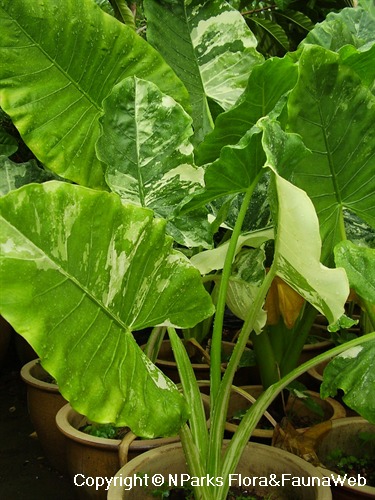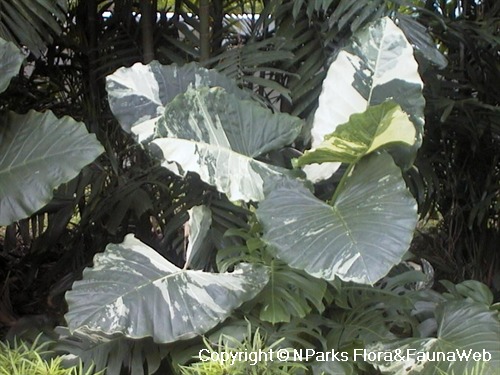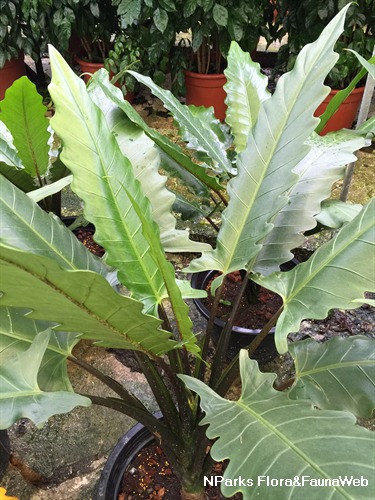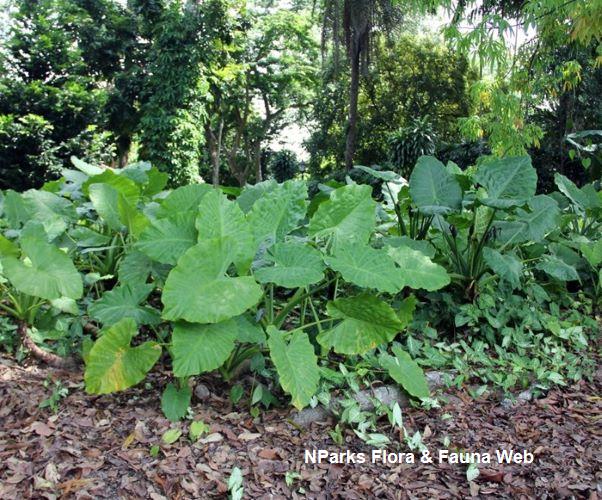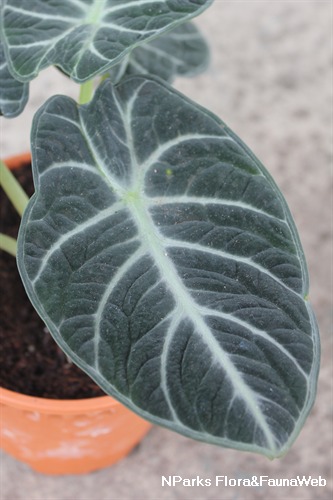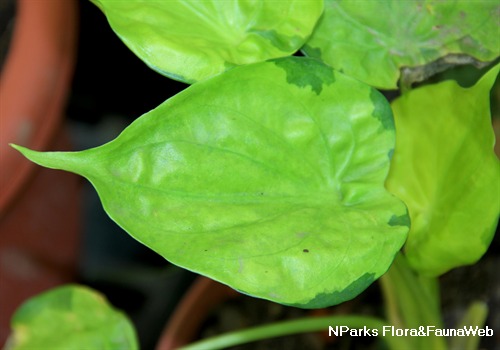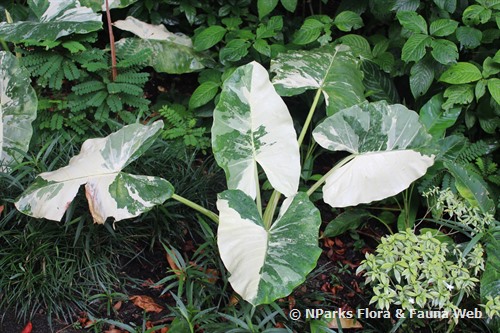
Back
Alocasia macrorrhizos 'Variegata'
| Family Name: | Araceae |
| Common Name: | Variegated Giant Taro, Variegated Elephant's Ear |
Alocasia macrorrhizos 'Stingray' is a large perennial herb that produces a rosette of large, erect leaves. This cultivar produces variegated leaves with irregularly sized patches and splotches of white, grey and/or cream on leaf blades and leaf stalks.
Name
Classifications and Characteristics
| Plant Division | Angiosperms (Flowering Seed Plants) (Monocotyledon) |
|---|---|
| Plant Growth Form | Herbaceous Plant |
| Lifespan (in Singapore) | Perennial |
| Mode of Nutrition | Autotrophic |
Biogeography
| Preferred Climate Zone | Tropical |
|---|---|
| Local Conservation Status | Non-native (Horticultural / Cultivated Only) |
Description and Ethnobotany
| Growth Form | It is a perennial herbaceous aroid that can reach up to 1 - 3 m, usually solitary, with 0 - 2 offshoots from the base. |
|---|---|
| Foliage | The leaves are held upright and arranged in a rosette at the tip of the stems. The leaf blades are rounded, arrowhead-shaped, bluntly triangular in shape. The sinus (indentation where the leaf stalk connects to the lateral lobes in aroids) is naked or open, with no connecting leaf blade between the posterior/lateral lobes. The leaf is variegated with irregularly sized patches and splotches of white, grey and/or cream on leaf blades and petioles (leaf stalks). |
| Stems | The stems are underground corms (thick, often round, modified stems) that elongate as the plant ages, either growing erect or decumbent (lying along the ground with the leafy shoot curving upwards). |
| Flowers | The inflorescence is an off-white spadix comprising of an appendix (a sterile rod-like upper portion of the spadix) and tiny fertile flowers in the lower portion. The appendix is equal to or exceeds half the length of the entire spadix. The spadix is subtended by a spathe; an upper portion is open, white to yellowish-green, and a bulbous, green enclosed portion surrounds the female flowers, separated by a tight 'waist'. The upper portion of the spathe becomes hood-like when the male flowers mature. The peduncle (inflorescence stalk) barely extends beyond the cataphyll (leaf-like structure that surrounds and protects a newly emerging leaf blade in aroids). |
| Cultivation | This species grows best in bright light with light shade and moist, but well-drained loamy soil. However, it can tolerate shade to full sun, and sandy to clayey soils. Shelter from harsh afternoon sun as the variegated portion of the leaves may burn and turn brown under direct sunlight. |
| Etymology | The generic epithet Alocasia is derived from the Greek terms, a- "not" and kolokāsiā "lotus root", alluding to its similarity to Colocasia, a closely-allied genus. The specific epithet macrorrhizos is Greek for "large roots," possibly referring to the thick, root-like stems. |
Landscaping Features
| Desirable Plant Features | Ornamental Foliage, Ornamental Form |
|---|---|
| Landscape Uses | Parks & Gardens, Focal Plant |
| Thematic Landscaping | Bioswales / Sunken Garden, Moonlight Garden |
| Usage Hazard - Cons | Irritant - Sap, Toxic Upon Ingestion |
| Usage Hazard - Cons Remarks | Irritant Sap/ Toxic Upon Ingestion: The slightly milky sap contains calcium oxalate raphides, which are needle-shaped crystals that can cause irritation to skin, mouth and throat. Keep plants away from children and pets. |
Plant Care and Propagation
| Light Preference | Semi-Shade |
|---|---|
| Water Preference | Lots of Water, Moderate Water |
| Plant Growth Rate | Fast to Moderate |
| Rootzone Tolerance | Moist Soils, Well-Drained Soils, Fertile Loamy Soils |
| Potential Problems | In wet, poorly-drained soil, the corms are prone to rot. |
| Pest(s) | Chewing Insects |
| Propagation Method | Division, Storage Organ (Corm) |
Foliar
| Foliage Retention | Evergreen |
|---|---|
| Mature Foliage Colour(s) | Green, White, Cream / Off-White |
| Mature Foliage Texture(s) | Glossy / Shiny, Thick |
| Foliar Modification | Flower/Fruit Bract |
| Foliar Type | Simple / Unifoliate |
| Foliar Arrangement Along Stem | Rosulate / Rosette |
| Foliar Attachment to Stem | Petiolate |
| Foliar Shape(s) | Non-Palm Foliage (Sagittate) |
| Foliar Margin | Entire - Wavy / Undulate |
| Foliar Apex - Tip | Acute |
| Foliar Base | Hastate |
| Typical Foliar Area | Megaphyll (>1640.25cm2 ) |
| Leaf Area Index (LAI) for Green Plot Ratio | 3.5 (Shrub & Groundcover - Monocot) |
Non - Foliar and Storage
| Stem Type & Modification | Herbaceous |
|---|---|
| Root Type | Underground (Fibrous Root) |
| Specialised Storage Organ(s) | Underground (Corm) |
Floral (Angiosperm)
| Flower & Plant Sexuality | Unisexual Flowers , Monoecious |
| Flower Grouping | Cluster / Inflorescence |
|---|
| Flower Location | Axillary |
| Inflorescence Type | Spathe & Spadix |
| Ovary Position | Superior / Hypogynous |
| Flowering Habit | Polycarpic |
Image Repository
Others
| Master ID | 344 |
|---|---|
| Species ID | 1640 |
| Flora Disclaimer | The information in this website has been compiled from reliable sources, such as reference works on medicinal plants. It is not a substitute for medical advice or treatment and NParks does not purport to provide any medical advice. Readers should always consult his/her physician before using or consuming a plant for medicinal purposes. |

